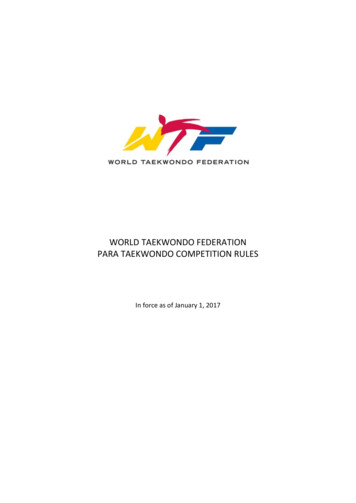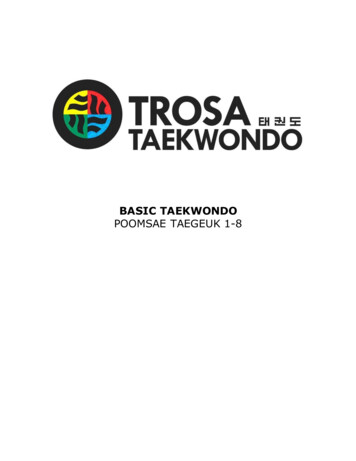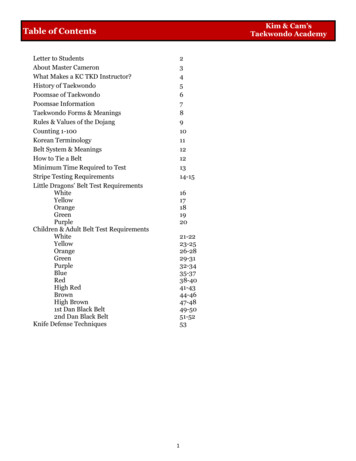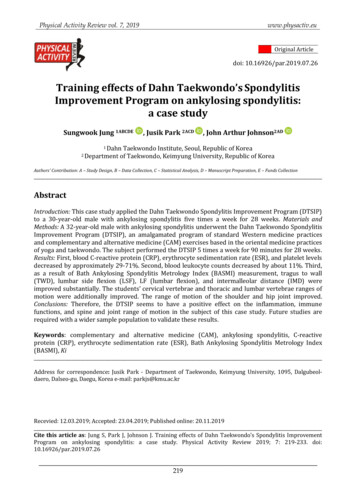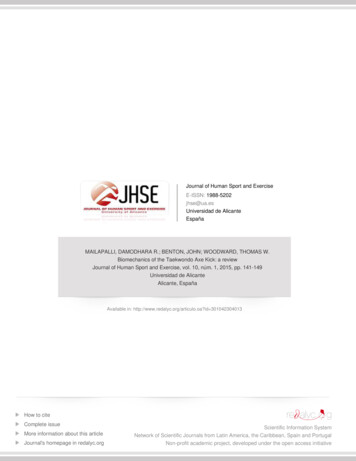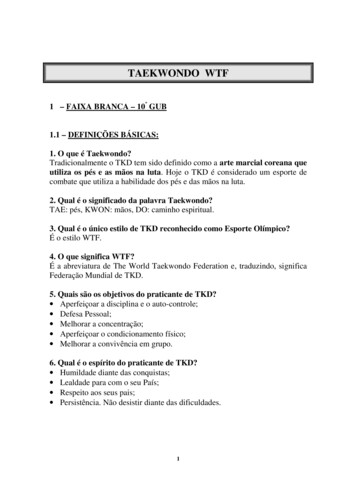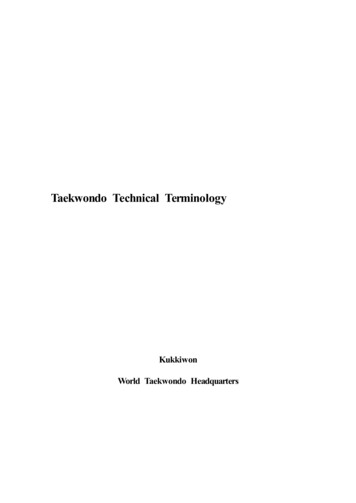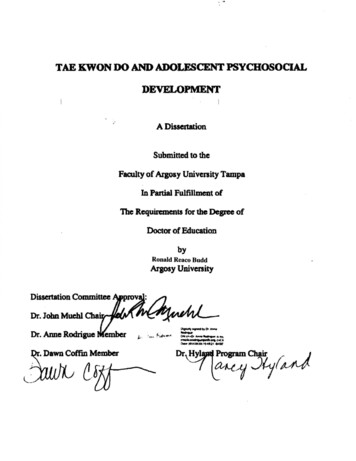
Transcription
.,TAEKWONDO AND ADOLESCENT PSYCHOSOCIALDEVELOPMENTA DissertationSubmitted to theFaculty of Argosy Univcnity TampaIn Partial Fulfillment ofThe Requin:ments for the Degree ofDoctor of EducadonbyRonald Reaco BuddAJ)osy University-- .,."'---\toi.DI t.OO - - - -· (o("J.O . . ! l l l t - - . l 1 .W. Dawn Coftin MemberDr gram ChairI,-.J. 1,.)'1(
ProQuest Number: 3734054All rights reservedINFORMATION TO ALL USERSThe quality of this reproduction is dependent upon the quality of the copy submitted.In the unlikely event that the author did not send a complete manuscriptand there are missing pages, these will be noted. Also, if material had to be removed,a note will indicate the deletion.ProQuest 3734054Published by ProQuest LLC (2015). Copyright of the Dissertation is held by the Author.All rights reserved.This work is protected against unauthorized copying under Title 17, United States CodeMicroform Edition ProQuest LLC.ProQuest LLC.789 East Eisenhower ParkwayP.O. Box 1346Ann Arbor, MI 48106 - 1346
TAE KWON DO AND ADOLESCENT PSYCHOSOCIALDEVELOPMENT 2013Ronald Reaco BuddALL RIGHTS RESERVEDi
TAE KWON DO AND ADOLESCENT PSYCHOSOCIALDEVELOPMENTA DissertationSubmitted to theFaculty of Argosy University TampaIn Partial Fulfillment ofThe Requirements for the Degree ofDoctor of EducationbyArgosy UniversityDissertation Committee Approval:Dr. John Muehl ChairDr. Anne Rodrigue MemberDr. Dawn Coffin MemberDr. Hyland Program Chairii
TAE KWON DO AND ADOLESCENT PSYCHOSOCIALDEVELOPMENTAbstract of DissertationSubmitted to theFaculty of Argosy University CampusCollege of Educationin Partial Fulfillment ofthe Requirements for the Degree ofDoctor of EducationbyRonald Reaco BuddArgosy UniversityDecember, 2012Chair: Dr. John MuehlCommittee:Dr. Anne RodrigueDr. Dawn CoffinDepartment: College of Educationiii
ABSTRACTThe following research was completed in an attempt to document the existence of anycorrelation between youth participation in Tae Kwon Do and various psychological and socialtraits evident within the participants. The data of this dissertation was gathered and recordedwithin the format of the qualitative case study. At the end of the case study the researcher wasable to document evidence that individuals who participate in Tae Kwon Do demonstratepositive psychological and social traits. It is the researcher’s hope that further studies will beundertaken to enhance the aggregate data base regarding participation in martial sports such asTae Kwon Do and positive psychological and social development.iv
TABLE OF CONTENTSPageCHAPTER ONE: THE PROBLEM . 3Introduction . . 3Need for the Study . . 4Human Development . . 4Developmental Activities 5A Competent Adult . . . 5Importance of the Study . . 6Theoretical Framework . . 6Significance of the Study 7Purpose of the Study . 8Central Question . 8Research Questions . . 8Personal Perspective . 9Definition of Terms . . 9CHAPTER TWO: REVIEW OF THE LITERATURE . 11v
Overview . 11Bronfrenbrenner’s Terms . 11Microsystem . 11Mesosystem . 12Exosystem . 136 Specific Traits of Developmental Competencies . 132 Traits of Social Competency: Cooperation & Self-Control . . 15Parental Involvement and Its Influence on Their Child’s Development . . 16Importance of Sport Participation . . 19Health Benefits of Sport . . 21Participation in Sport and Mental and Social Development . 21Previous Definitions of Social and Developmental Competencies . 27Martial Arts . 28Martial Arts and Cognitive Development . 29Tae Kwon Do . . 31History of Tae Kwon Do . 32Organizational Structure: The Belt System . 32Bronfenbrenner, The Belts of Tae Kwon Do & Metaphor . 34Curriculum . . 35Tae Kwon Do Curriculum 36Self-Reporting Bias in Qualitative Research 36vi
CHAPTER THREE: METHODOLOGY . . 39Overview of the Methodology Section . 39Statement of Subjectivity . . 39Research Design 41Philosophical Assumptions . 43My Worldview . 43Researcher’s Personal and Professional Bias . 43Data Analysis 45Central Premise of Study . 46Choice of Population . . 46Population and Sampling Procedures . 46Instrumentation . 49Procedures 50Methodological Assumptions, Limitations and Delimitations . 51Assumptions . 51Limitations 52Delimitations . . . 52vii
Conclusion of Chapter Three . . 52CHAPTER FOUR: FINDINGS . . 54Introduction to Chapter Four 54Crystallization of the Data . 55Implementation . 56Section One: Personal Testimonials . 56Respect, Self-Confidence, Physical Fitness, Mental Health and the Tae Kwon Do Lifestyle . 57Respect . . 57Self-Confidence . . 58Physical Fitness and Appearance . 58Mental Health . 59The Tae Kwon Do Lifestyle . . 60Other Miscellaneous Topics . . 60Section Two: Interviews . . 61Discipline, Mastery, Respect, Physical Efficacy and Future Goals . . 61Discipline . 62Mastery . 63viii
Respect . 63Physical Efficacy . 63Future Goals . 64Section Three: Personal Observations . 64Introduction and Overview . . . 64Tranquility, Discipline, Respect and Physical Efficacy 67Tranquility . . 67Discipline . 68Respect . . . 68Physical Efficacy . . 69Conclusion to Chapter Four . . 71CHAPTER FIVE: SUMMARY, CONCLUSIONS, AND RECOMMENDATIONS. 72Research Questions Revisited . . 72Data Gathering Purpose 73Summary of the Findings . 73Final Comments and Conclusions on the Author’s Bias and Subjectivity . . 74The Research Questions Revisited in Context . . 74ix
Why did the current participants choose to take Tae Kwon Do?.74Did the staff work consciously subconciously to impart competencies that are critical in thedevelopment of their students emotional and psychological well being?. 76Did the students see evidence of these competences within their personal development?. 76From my perspective, the following is my evidence for the following critial psychologicalcompetencies being specifically imparted and developed through the curriculum and practicalinstruction . 77Secondly and once again from the perspective of my research, is there any evidence of thefollowing two critical social competencies being specifically imparted through the curriculumand practical instruction?. 80Implications for further Research . . 83Outliners in the Study . . . . 81Surprises in the Data . 81My Professional Recommendations . . 81Conclusions for Chapter Five . . 82Final Thoughts . . 84REFERENCES . . 87APPENDIXES . . 104x
Appendix A: Participant Consent Form 105Appendix B: Parental Consent Form . . 108Appendix C: Confidentiality Agreement . 111Appendix D: Student Questionnaire . 112Appendix E: Faculty & Staff Questionnaire . 115Appendix F: Direct Observation Log . 119Appendix G: Audio Transcription of an Interview 121Appendix H: Personal Testimonial 148Appendix I: Personal Testimonial Log . 149Appendix J: Completed Direct Observation Log 150xi
ACKNOWLEDGMENTSThe author would expresses sincere gratitude to committee members, Dr. John Muehl,Dr. Anne Rodrigue, and Dr. Dawn Coffin, for their invaluable support and guidance inthe planning and implementation of this research project. The deepest appreciation goesto the managers and employees of J. Park’s Tae Kwon Do Dojang in Tampa, Florida fortheir participation in this research study. The author also wants to thank the faculty andstudents at Argosy University for their contributions of time and resources. Additionally,I thank G-D above for getting me through this difficult task. Without their help, thecompletion of this dissertation would have been impossible.i
1
CHAPTER ONE: THE PROBLEMIntroductionThe traits and qualities comprised by a person’s entity, contributing to a successful individual,are many (Walker, 2003). When considering all the various methods utilized to develop a youngperson into a successful and competent adult, one can’t ignore the wide array of choices parentshave. Also, parents don’t always know the best after school activities available to developcritical competencies essential for success in their kids and this dissertation will providequalitative data to assist them in their decision making process. In making the right choice fordevelopmentally appropriate activities for their child, parents must choose the best alternativesrather than the least desirable ones (Thrall, 2010). Studies have shown participation in sports hasa positive corollary relationship with academic, physical, and social self-concepts (Fawcett,2007). Concerned parents seeking to develop competent, offspring want to know just whatactivities can best enhance the development of their children into a competent individual. In thisstudy I provided information to help concerned parents choose the best extracurricular activitiesfor their children to participate in.In this study evidence was uncovered of the beneficial developmental qualities within middleand high school Tae Kwon Do students as a result of their exposure to the curriculum and theinstructors. Specifically, I looked for evidence of the traits comprised by the two components ofindividualized developmental competencies and socialized group social competencies. Thisdissertation was concerned with participation in Tae Kwon Do to create a testimonial from thestandpoint of its participants and the effect that Tae Kwon Do has on adolescent developmental3
outcomes. This paper was completed by interviewing and recording the responses of theparticipants of J. Park’s Tae Kwon Do Dojang in Tampa, Florida. This interviewerconceptualized and designed a study concerned specifically with how Tae Kwon Doparticipation effects the psychological and social development of its adolescent participants. Itwas initially my contention p that participation in Tae Kwon Do contributed to the developmentof an adolescent into a healthy individual. In this study I sought evidence to support or repudiatethis claim.Need for the StudyConcerned parents seek to impart, grow, and nurture developmental and social competenciesin their children. Parents, in the best interest of their child, attempt to engage their offspring inactivities that can best enhance their child’s development, with the ultimate desire of eventuallyhelping their child to develop into a healthy and productive adult citizen. However, parentsdon’t always know the best ways to develop critical competencies essential for success in theirchild’s future. Tae Kwon Do is an activity where many children participate. No study to date hasresearched the psychological and social effects adolescent participation in Tae Kwon Do affords.In this dissertation links between adolescence participation in Tae Kwon Do and the presence ofpsychological and social characteristics essential for successful human development were soughtby the researcher.Human DevelopmentThe seminal researcher, for the purpose of my study, was Urie Bronfenbrenner. UrieBronfenbrenner provided a concise definition for human development. Bronfenbrenner wrote:Human development is the process through which the growing person acquiresmore extended differentiated, and valid conception of the ecological environment,4
and becomes motivated and able to engage in activities that reveal the propertiesof, sustain, or restructure that environment at levels of similar or greatercomplexity in form and content (1978, p. 27).Tae Kwon Do is a sport and a discipline explicitly attempting to enhance human developmentthrough the participant’s application of its mental and physical doctrine (Kim, 1985). Thisdevelopment is facilitated by conduits or instructors employed by the dojang master. In TaeKwon Do, instructors attempt to develop the individual into a living ideal of the disciplinethrough both philosophical and physical activities (Kim, 1985).Developmental ActivitiesEvidence supports participation in sports contributes to greater psychological well-being andgreater mental health (Greenleaf, Boyer, & Petrie, 2009). Activities like sports “influence thedevelopment of key psychological characteristics or factors that in essence contribute to apositive psychological outcome” (Greenleaf, et al, p. 715, 2009). Psychology experts contendsports activity enhances feelings of instrumentality and psychological well-being (Parsons &Betz, 2001). Instrumentality is defined as, an individual’s personal perceived ability level andthe personal goal set by that individual based upon this perception (Ino-Oka, & Matsui, 1977).Tae Kwon Do is a sport whereby its adherents claim lead to positive outcomes such as feelingsof instrumentality and ultimately contributing to the development of a competent adult (Kim,1985).A Competent AdultParents’ and educators’ desires are to develop a competent child. What is an academicallyaccurate definition of a competent person and, what can be described as the traits possessed by acompetent person? A simple definition of a competent person is one who is able to make use of5
environmental and personal resources to achieve a good developmental outcome (Schneider,1989). Sroufe (1983) and the researchers Givner, Lane, and Pierson (2004) provided us withanother definition of a competent adult. According to Sroufe, a competent adult possesses 6psychological competencies. They are: a) Physiological Regulation, b) Management of Tension,c) Establishing an Effective Attachment Relationship, d) Exploration and Mastery, e)Individuation, f) Management of Impulses, (1983). Givner, Lane, and Pierson reported that acompetent adult possessed two social competencies, which were the ability to cooperate and theability to exercise self-control (2004). In aggregate, a competent adult possesses bothpsychological and social competencies.Importance of the StudyThis study was important because the collected data sought to document and record (from thestandpoint of the practitioners) the psychological and social effects experienced by theadolescent practitioners of the sport of Tae Kwon Do on their overall sociological apsychological development. Ultimately, the information collected enhances the seminalaggregate data pool related to the psychological and social effects individuals report exist as aresult of participation in a sport such as Tae Kwon Do.Theoretical FrameworkUrie Bronfenbrenner developed the Ecological Systems Theory (1979). This theory meritsmentioning because the Theory of the Ecological Perspective of Human Development (as it isalso known) has enabled this researcher to crystallize the roles of the various stakeholders withinthis study. It has also helped the researcher to form a theoretical paradigm used as a cognitiveand conceptual framework. Within Bronfenbrenner’s theory, the idea is introducessystems/groups of stakeholders forming an environment and interacting within that environment6
(York, 2000). Bronfenbrenner identified, divided and described 5 systems and theirinterconnected relationships within all complex human social environments. Three of thesesystems were useful in this study. They were microsystems, mesosystem and exosystems.Proponents of Bronfenbrenner’s ecological perspective of human development argue thedevelopmental outcomes of an individual takes place within interconnected elements(environments). Richard York described these interconnected elements as environments, whichcan be understood as different levels of contexts where people operate. Some of theenvironments are more immediate, while others are more distant (York, 2000). Bronfenbrennerdescribed several environmental systems where an individual develops. Three of those systemswere incorporated into the ideological paradigm of this study. Most the research for this studywill focus upon the realm of the Tae Kwon Do Dojang acting as a microsystem where the relatedparticipants interacted in the micro-environment of the dojang (the term dojang is the Koreanword for gym).Significance of the StudyThe data acquired in this research from recorded interviews, is also useful for parents andresearchers who are attempting to decide what type of activities might best enhance anadolescent child’s psychological and emotional development. Teachers, and those who workwith young adolescents, can also benefit from this data because it documents some of thepsychological and social results of participating in Tae Kwon Do. Finally, the research dataprovides help for concerned individuals when deciding about guiding youth into potentialavenues of growth, development, and actualization. Additionally, it was the hope of theresearcher that the evidence presented in this study informs the research community about a7
potential method of sport participation which works at enhancing the positive development ofmiddle and high school aged children.Purpose of the StudyThe purpose of this case study was to describe any evidence (as provided by the participants)between an adolescent experiencing and learning Tae Kwon Do and the development ofpsychosocial characteristics necessary for an individual’s entrance into adulthood. In thisresearch, psychosocial characteristics were generally defined as comprising both developmentaland social characteristics defined in this study (see p. 9).Central QuestionDoes learning Tae Kwon Do lead to the development of critical developmental (Sroufe, 1983)and social competencies (Bierman, & Welsh, 2001) within the psychological makeup of the 7ththrough 12th grade adolescent participants? This dissertation attempted to answer this centralquestion through the exploratory qualitative case study model applied to the 7th through 12thgrade students and the adult staff of J. Park’s Tae Kwon Do Dojang in Tampa. In implementingthis case study, the researcher sought to understand why students engage in Tae Kwon Do andhow it influenced their personal growth and development.Research QuestionsThe specific research questions in this study were: 1) Why did the current participants chooseto take Tae Kwon Do? 2) Do the staff and faculty work consciously or subconsciously to impartcritical competencies in the development of their students emotional and psychological wellbeing? 3) Do the students see evidence of these competences within their personal development?8
4) Is there any evidence of these critical competencies being specifically imparted through thecurriculum?Personal PerspectiveFinally, I would like to personally position myself within this research by adding this studywas important to me because of the experiences I have had with learning the discipline of TaeKwon Do. I have been a student of this art since 2008 and am currently a holder of the purplebelt. For me, on a personal level, I have benefited both spiritually and psychologically on mypresent journey to master Tae Kwon Do. It is my intention to document the benefits of thissport. This can be accomplished through a qualitative case study. From my perspective,qualitative case study is broad enough (in the creation of its narrative) where that all bits ofinformation provide analyzable, testimonial data useful in constructing the final written product.Definition of TermsFor the purpose of this study the following terms were defined:Competencies. According to the Washington State Department of Personnel website (2010),“Competencies are measurable or observable knowledge, skills, abilities, and behaviors criticalto (social interaction and). successful job performance” (n.p.).Developmental Competencies. According to the Wisconsin Department of Public Instruction,“Developmental competencies, which are types of functional life competencies (arecompetencies that) each person must attain in order to learn, achieve academic success, andprepare for a satisfying and productive career” (1986, p. 12). They are best viewed asindividualized personality traits (1986).9
Social Competencies. The Encyclopedia of Childhood and Adolescence defines socialcompetencies as the social, emotional, and cognitive skills and behaviors that children need forsuccessful social adaptation (Bierman &Welsh, 2001).Tae Kwon Do. According to Dr. Park’s book, J. Park’s Essence, Tae Kwon Do: From WhiteBelt to 4th Dan Tae Kwon Do is defined as the art and lifestyle of fighting with fists and feetthrough punching, jumping, and kicking (1995).10
CHAPTER TWO: REVIEW OF THE LITERATUREOverviewThe following literature review comprised a sample of current published research associatedwith the topic of this dissertation. Some of the topics included in this literature review areconcerned with developmental theory, sport participation, martial arts, and Tae Kwon Do. Theseand other topics are reviewed by the researcher based upon previous published academicresearch in books and academic journals and to lay a foundation for the dissertation’s subjectmatter.Bronfrenbrenner’s TermsBronfrenbrenner’s theory of Ecological Human Development forms the essential guidingframework of this dissertation. This is due in part to his theory’s ability to explain theinterconnection and interaction of the various components that exist within environmentalsettings. Bronfenbrenner described these environmental settings in terms of systems comprisedof structures through where the individual must interact and exist. These systems influence andare influence by their individual components. The following three systems are the most relevantto this study.MicrosystemThe microsystem is the area closest to the child and contains the structures where the childhas immediate contact. The microsystems encompass the relationships and interactions childrenhave with their immediate surroundings. Structures in the microsystems include family, school,neighborhood, or childcare environments. Moreover, according to Bronfenbrenner, “Amicrosystems is a pattern of activities, roles, and interpersonal relations experienced by thedeveloping person in a given setting with particular physical and material characteristics”11
(Bronfenbrenner, 1979, p. 22). At this level, relationships have impact in two directions awayfrom the child and toward the child. For instance, a child’s parents may affect his beliefs andbehavior; however, the child also affects the behavior and beliefs of the parent. Bronfenbrennernamed these bi-directional influences, and he demonstrated how they occur among all levels ofenvironment (Bronfenbrenner, 1979).The interaction of structures within one of the identified and described layers, and theinteractions of structures between layers, is paramount to this theory. At the Microsystems level,bi-directional influences are greatest and have the greatest impact on the child (Bronfenbrenner,1979). However, interactions at the outer levels have the ability to impact the inner structures. Inthe case of this study the primary “setting” or place where people can readily engage in face-toface interaction is the dojang (Bronfenbrenner, 1979). The definition of dojang, according toTae kwon Do Master Y.K. Kim is the place where one practices and learns the way or method ofTae Kwon Do (1985). Interpreted in Bronfrenbrenner’s paradigm the “activity” is learning TaeKwon Do. The “role” is that of student, parent, or teacher. The “interpersonal relationships”elevate each of the stakeholders into a higher Zone of Proximal Development (Vygotsky, 1978).The zone of proximal development as defined by Vygotsky is, “ The distance between the actualdevelopmental level as determined by independent problem solving and the level of potentialdevelopment as determined through problem solving under adult guidance or in a collaborationwith more capable peers” (1978, p.86).MesosystemThe mesosystem is the connection between the structures of the child’s microsystems. Someexamples are, the connection between the child’s teacher and his parents, between his school andhis neighborhood and other connected environments (Bronfenbrenner, 1979). The mesosystem12
also, “comprises the interrelations among two or more settings in which the developing personactively participates such as, for a child, the relations among home, school and neighborhoodpeer group; for an adult, among family, work and social life” (Bronfenbrenner, 1979, p 25). Inthis research, the interrelating settings are the dojang, school, community and immediate family.ExosystemThe exosystem is the area defining the larger social system where the child does not functiondirectly. In the exosystem there are one or more settings that do not involve the developingperson as an active participant. The structures in this layer impact the child’s development byinteracting with some structure in their microsystems. The exosystem affect the individual andthe setting. Government policies, or the demographics of the larger community, are goodexamples. The child may not be directly involved at this juncture but the child does feel thefactors involved within the system (Bronfenbrenner, 1979).Recognizing Bronfenbrenner’s Ecological Perspective of Human Development as the theoreticalframework forming the cognitive paradigm behind my study, this research attempted tocrystallize the Ecological Perspectives Theory as the outside framework affecting thedevelopmental process by interacting directly and indirectly with the young person’sdevelopment.Six Specific Traits of Developmental CompetenciesIn this study the researcher defined development as the changes taking place within a person’spsychological makeup over a given time frame. These changes can best be recognized as specifictraits or components of a person’s psychological composition created and cultivated within themind as a result of stimuli. These changes are understood as adaptations to outsideenvironmental circumstances. These adaptations are either beneficial to the individual in terms of13
results produced, or detrimental in terms of results produced. If the adaptations are beneficial,then the results are an individual’s ability to experience an actualization of their desires, and agreater efficacy in their daily life experience. If the adaptations are detrimental, theactualizations of the individual’s desires are stifled and personal efficacy is limited.The first competency is homeostasis. According to The Dictionary of Psychology,homeostasis is the psyche in balanced equilibrium or a balanced/ stable mental state (Corsini,1999). Stress management involves controlling and reducing the tension occurring in stressfulsituations by making emotional and physical changes. The degree of stress and the desire tomake the changes determines how much change takes place (Corsini, 1999). The next conceptaddresses establishing an effective attachment relationship (bonding). According to TheDictionary of Psychology, bonding can be described as the process by which individuals becomeemotionally attached to one another (Corsini, 1999). The forth definition described bothexploration and mastery. Exploration was defined by the APA Dictionary of Psychology, as theconfidence of an individual to examine their environment in an attempt to successfully orientthemselves to their current situation (Anonymous, 2007). Mastery is defined by The Dictionaryof Psychology as the impetus to be in control of inner drives and the outside environment. Inaddition to mastery, is the drive to be a successful individual (Cors
TAEKWONDO AND ADOLESCENT PSYCHOSOCIAL DEVELOPMENT A Dissertation Submitted to the Faculty of Argosy Univcnity Tampa In Partial Fulfillment of Dawn Coftin Member
